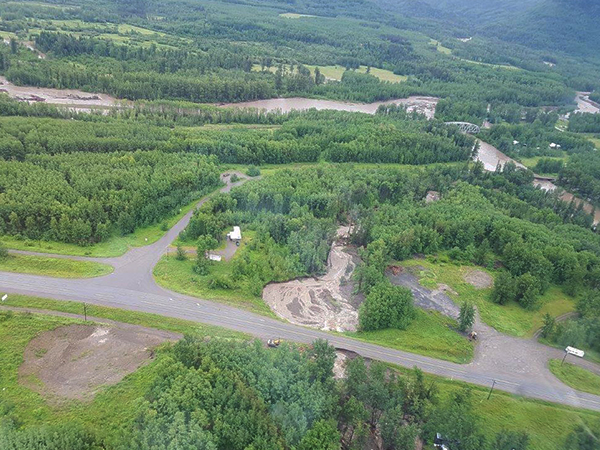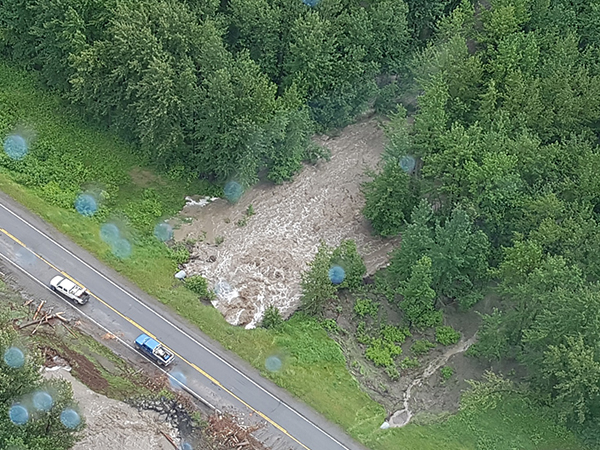British Columbia has implemented a flood mitigation activity, commissioning work at five locations west of Chetwynd, replacing culverts with bridges in order to permit safe travel along Highway 97, particularly in the event of heavy rain and flooding.
The ministry is investing $26.8 million on this flood mitigation strategy. These projects are in addition to recovery work that has been ongoing since June 2016 when severe flooding caused extensive damage throughout the Peace District.
“The 2016 floods caused a lot of hardship for people in the Peace District, and we want to make sure our infrastructure can withstand future flooding events,” said Claire Trevena, Minister of Transportation and Infrastructure. “These are significant infrastructure projects which will boost safety and reliability for people travelling on Highway 97, particularly during heavy rain.”
Existing culverts at the five locations below are being replaced with modern two-lane bridges capable of withstanding a 200-year flood level. New highway approaches are being constructed on both sides of each bridge, and works will be done to stabilize the creek banks.
Bowlder Creek
Location: Highway 97, approximately 23 kilometres west of Chetwynd
Contractor: Formula Contractors Ltd. from Prince George
Total project cost: $7.1 million

Commotion Creek
Location: Highway 97, approximately 20 kilometres west of Chetwynd
Contractor: Cewe Infrastructure Ltd. from North Vancouver
Total project cost: $7.3 million
Stone Creek
Location: Highway 97, approximately 16 kilometres southwest of Chetwynd
Contractor: Surespan Construction Ltd. from North Vancouver
Total project cost: $4.6 million
Tippy Corner Creek
Location: Highway 97, approximately 45 kilometres west of Chetwynd
Contractor: Surespan Construction Ltd. from North Vancouver
Total project cost: $3.8 million
Willow Flats
Location: Highway 97, approximately 42 kilometres southwest of Chetwynd
Contractor: Surespan Construction Ltd. from North Vancouver
Total project cost: $4 million
Construction on the five projects has begun and is expected to be substantially complete by fall 2018.










Another method for seismic retrofittingof structures is covering the damaged area with FRP materials which has gained notable acceptance from the civil engineering community in recent years. FRP composite materials possess superior mechanical properties including:
Impact resistance.
Strength.
Stiffness.
Flexibility.
Ability to loads.carry
The wallmesh system, or in other words wallmesh, is one of the most innovative construction methods that restrains and strengthens non-structural walls. This system is inspired by the FRCM (Fabric-Reinforced Cementitious Matrix) system. This system includes fiberglass network mesh (AR glass fibers) or carbon fiber mesh as a stable reinforcement and cement-based polymer mortar with high strength and special formulation that turns the carbon and glass composite network into a strong layer. wallmesh is made of materials such as carbon fiber and fiberglass and plays an essential role in maintaining non-structural walls.
bed rebar
The bed rebar can be installed horizontally or vertically, each with its own advantages and calculations. Also, the wall mesh method is done without bed rebar, it uses glass fiber networks that have advantages in terms of cost and speed of implementation. The proper use of these methods according to the type and hazards of the building can help the resistance and safety of the structure.
Wall mesh are among the methods approved by the engineering system to restrain non-structural walls. According to evaluations, wall mesh is the best option for stabilizing walls. This method is both better and more affordable than traditional methods. Wall mesh is a more suitable option for restraining and stabilizing walls, based on the evaluations. The costs of implementing wall mesh, the factors affecting the price of wall mesh, as well as its comparison with traditional wall posts, etc., have been discussed.